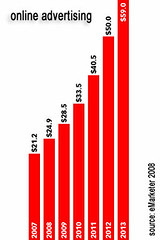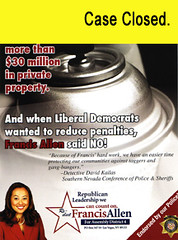Dave Fleet is a communications professional based in Toronto with a self described passion for social media. I was recently reintroduced to his blog via The Buzz Bin after Mike Nelson included it among the posts selected for “Great Blogs of Fire!”
Dave Fleet has a good blog, no question. But the highlighted post? It’s only close.
How Might Friedman’s Flat World Affect The Public Relations Industry?
Fleet takes journalist Thomas Friedman’s sixth chapter and applies it to public relations and other communication fields, establishing that public relations can stay ahead an increasingly competitive global market by anchoring and becoming really adaptable.
The second point, adaptability, has always been part of the communication equation and has very little to do with flattening. Public relations, along with communication, is one giant exercise in staying ahead of the curve.
But the first point, anchoring, can easily be misinterpreted. It deserves some check and balance. While there is some truth that anchoring (knowing your market) provides some advantages, it can also diminish your competitive value on the global stage and tie you, sometimes fatally, to one market.
For example, although I would not classify my company as a public relations firm, our out-of-market and international assignments are expanding, not retracting. In other words, it’s working in reverse. And it suggests to me that communication remains wide open, requiring companies to expand in both directions — local presence and international market penetration.
Knowing this also leads me to the other portion of his post that caught my attention. Despite the prevalence of English overseas, writing is not so at risk.
Sure, it’s possible. As the editor of an international trade publication several years ago, I worked with more than 40 writers located all over the world. We still tap the best of them on select assignments from time to time.
However, after contracting overseas writers during that five years, I learned to appreciate that the prevalence of English and the quality of English writers does not necessarily go hand in hand. In fact, often times, some of the best assignments came from English and Canadian writers living abroad in places like India and Hong Kong. Don’t get me wrong, we worked with Indian and Chinese freelancers too. Nationality wasn’t an indicator of a great writer, which is why I think Fleet might be upside down in placing writers at risk.
Still, there are distinctions. For example, there is a significant difference between a correspondent who can write a decent article and a copywriter who understands how to fuse strategic communication, key contrast points, demographics, and psychographics into advertising copy well enough that it doesn’t read like one-way communication.
More to the point, I think what Fleet touches on is that there are many businesses out there, especially public relations firms, that entrust too much communication — releases and correspondence — to unseasoned professionals and interns without enough oversight by senior writers.
When you consider the impact that communication can have on a brand over the long term, I think it would be a mistake to hire writers based on nothing more than the number of dictionaries they happen to own and a price point. So no, writers are not at risk as long as companies continue to understand that the ability to write and the ability to generate results with words are not the same thing.
Dave Fleet has a good blog, no question. But the highlighted post? It’s only close.
How Might Friedman’s Flat World Affect The Public Relations Industry?
Fleet takes journalist Thomas Friedman’s sixth chapter and applies it to public relations and other communication fields, establishing that public relations can stay ahead an increasingly competitive global market by anchoring and becoming really adaptable.
The second point, adaptability, has always been part of the communication equation and has very little to do with flattening. Public relations, along with communication, is one giant exercise in staying ahead of the curve.
But the first point, anchoring, can easily be misinterpreted. It deserves some check and balance. While there is some truth that anchoring (knowing your market) provides some advantages, it can also diminish your competitive value on the global stage and tie you, sometimes fatally, to one market.
For example, although I would not classify my company as a public relations firm, our out-of-market and international assignments are expanding, not retracting. In other words, it’s working in reverse. And it suggests to me that communication remains wide open, requiring companies to expand in both directions — local presence and international market penetration.
Knowing this also leads me to the other portion of his post that caught my attention. Despite the prevalence of English overseas, writing is not so at risk.
Sure, it’s possible. As the editor of an international trade publication several years ago, I worked with more than 40 writers located all over the world. We still tap the best of them on select assignments from time to time.
However, after contracting overseas writers during that five years, I learned to appreciate that the prevalence of English and the quality of English writers does not necessarily go hand in hand. In fact, often times, some of the best assignments came from English and Canadian writers living abroad in places like India and Hong Kong. Don’t get me wrong, we worked with Indian and Chinese freelancers too. Nationality wasn’t an indicator of a great writer, which is why I think Fleet might be upside down in placing writers at risk.
Still, there are distinctions. For example, there is a significant difference between a correspondent who can write a decent article and a copywriter who understands how to fuse strategic communication, key contrast points, demographics, and psychographics into advertising copy well enough that it doesn’t read like one-way communication.
More to the point, I think what Fleet touches on is that there are many businesses out there, especially public relations firms, that entrust too much communication — releases and correspondence — to unseasoned professionals and interns without enough oversight by senior writers.
When you consider the impact that communication can have on a brand over the long term, I think it would be a mistake to hire writers based on nothing more than the number of dictionaries they happen to own and a price point. So no, writers are not at risk as long as companies continue to understand that the ability to write and the ability to generate results with words are not the same thing.






















